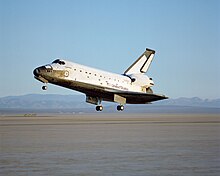
First of the line…
Today is the anniversary of yet another dark day in space exploration. On this date in 2003, the space shuttle Columbia (OV-102) broke up during re-entry, killing all seven crew members. A hairline fracture in the leading edge of the port wing, caused by falling ice during the January 16th launch, allowed superheated plasma to enter the superstructure of the shuttle during re-entry, causing it to break up.
The names of her crew were Rick D. Husband, William McCool, Michael P. Anderson, David M. Brown, Kalpana Chawla, Laurel B. Clark, and Ilan Ramon.
In contrast with the loss of Challenger, seventeen years earlier, my reaction to the loss of Columbia was one of outrage and anger. Columbia failed because of bad management and political inertia, things that were theoretically corrected after the Challenger accident. As I understand it, for almost the entire 16-day mission, mid-level engineers at NASA (and it’s contractors) were frantically trying to inform mission control about possible damage to the orbiter’s leading wing edge, and were trying to come up with alternatives, but to no avail. The high level executives at NASA were more concerned about their political positions and their professional reputations than with the welfare of the astronauts.
On top of this, the loss of Columbia showed that the Space Shuttle system, while an amazing piece of engineering, was a fundamentally flawed and unreliable system. There were just too many places where things could go wrong. In truth, many people, including many aerospace engineers who helped develop the system, had been saying this for a long time. Many have since stated that the space program should have chosen a different avenue back in the 1970s, and gone with something other than the shuttle.
The shuttle program is now finished, and at the moment, the United States is currently developing a replacement system. A lot of space development is now being handled by the private sector. This may actually turn out for the best, at least for now. Even so, I can’t help but be skeptical. But at the same time, I’m not hopeless.
I have one rather flippant question to pose. The worst accidents in the history of the United States space program have all taken place in late January. Why does NASA still launch manned vehicles during this time period?
